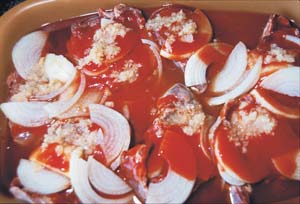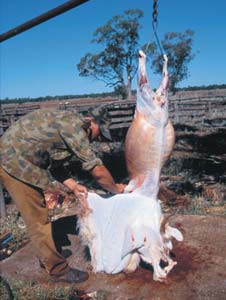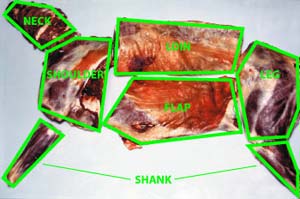Preparing and cooking goat
by Bob Hart
Hunter 5
 In parts of Europe kid goat meat is called capretto, while mature goat meat is called chevon. Like any meat it is best to prepare a young animal for a meal. Any goat from about one year of age or younger will do fine; however, a two- or three-year-old nanny should be okay, providing she is not on heat.
In parts of Europe kid goat meat is called capretto, while mature goat meat is called chevon. Like any meat it is best to prepare a young animal for a meal. Any goat from about one year of age or younger will do fine; however, a two- or three-year-old nanny should be okay, providing she is not on heat.
Preparation
After the harvesting has been done, the hard work begins. The animal should be moved to a place where it can be processed in a fairly hygienic way. First, the goat must be skinned. Once the shanks and head are removed, the skinning should start on the inside of the legs and the neck. Once completed, the animal should be hung up by the back legs and the skinning of the body commences. If you are near water, it is a good idea to wash down the carcass to remove any hair.
The next step is to take a small, sharp knife and cut around the anus and thus free it from the body. With this done, an incision is made in the lower abdominal area and cut down towards the chest cavity. The organs will fall out and should be completely removed. The carcass should be thoroughly cleaned and, if possible, hung up in a cool room for a day or two. If this cannot be achieved, it should be cut up in to edible pieces.
 The next procedure is best done with a saw and a good quality knife. The neck is removed and cut into cutlets and then the body is sawed into two equal parts. The shoulders and legs are removed, leaving the loin and flap to be cut up. The butchering is no different than cutting up a lamb or sheep. Remember to keep everything as clean as possible. No-one likes the look of meat covered with dirt and hair.
The next procedure is best done with a saw and a good quality knife. The neck is removed and cut into cutlets and then the body is sawed into two equal parts. The shoulders and legs are removed, leaving the loin and flap to be cut up. The butchering is no different than cutting up a lamb or sheep. Remember to keep everything as clean as possible. No-one likes the look of meat covered with dirt and hair.
Cooking
Chevon is similar to mutton except it has a gamier taste, but basically goat meat can easily be cooked in the same manner as lamb or mutton. Here are a few ways of serving goat:
- The neck:
Place the neck cutlets in a baking dish. Cover the cutlets with sliced onions and heaps of crushed garlic. Then cover the lot with a tin of tomato soup. Marinate for five hours or even a day in the fridge. Cover the meat with foil and cook in a preheated oven at 150°C for four to five hours. Let it cool and skim off any fat. Reheat and serve on a bed of noodles or rice - absolutely fabulous.
- The leg, loin or flap:
Garnish the leg with rosemary, thyme, salt and pepper. Slice little pockets in the leg and place in slivers of fresh garlic. With loin and flap use crushed garlic. Place the meat in an oven bag and cook in preheated oven at 150°C for three to four hours and serve with baked vegetables such as potatoes, pumpkin, carrots and onions.
 The shoulder:
The shoulder:
A Greek friend once told me that if you want to make tough meat tender, cook it for a very long time with a gentle, low heat. One of the easiest ways to do this is to cook any tough meat in a crock-pot set on the low setting. Garnish the same as you would the leg. I once cooked a shoulder from an old nanny in a crock-pot for 22 hours and it was very tender and succulent.
- A boned-out leg:
Place the leg in a baking dish and garnish as follows:- 3 tablespoons of oil
- 1 tablespoon of vinegar
- 1 bay leaf
- Light sprinkle of chilli powder
- Pinch of garlic salt
- Thyme
- Parsley
- 3 tablespoons of soy sauce
